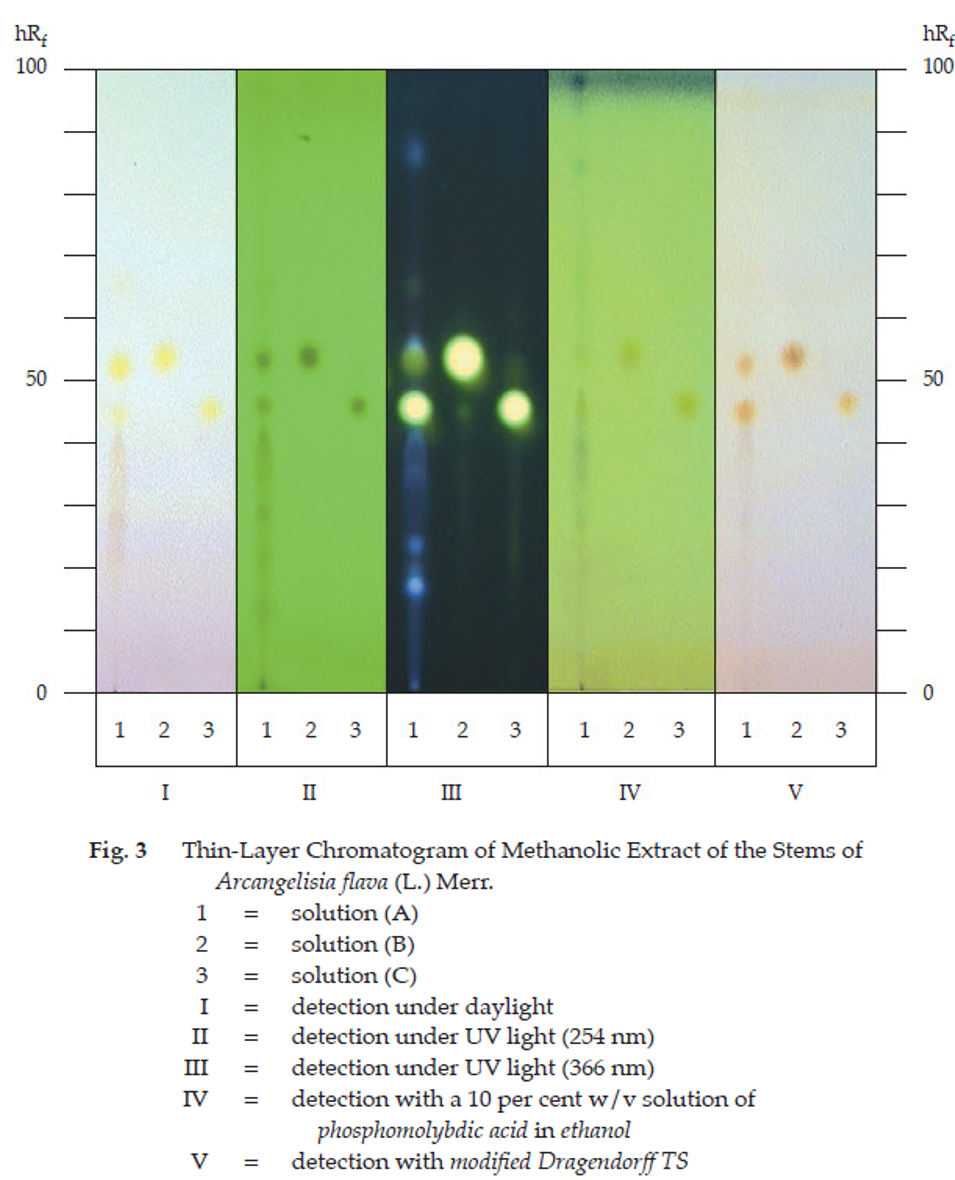ตำรามาตรฐานยาสมุนไพรไทย
Thai Herbal Pharmacopoeia
สำนักยาและวัตถุเสพติด กรมวิทยาศาสตร์การแพทย์ กระทรวงสาธารณสุข
Bureau of Drug and Narcotic, Department of Medical Sciences, Ministry of Public Health(Tinospora crispa (L.) Hook.f. & Thomson)
(Nelumbo nucifera Gaertn.)
(Centella asiatica (L.) Urb.)
(Centella Dry Extract)
(Centella Cream)
(Mesua ferrea L.)
(Piper sarmentosum Roxb.)
(Piper sarmentosum Roxb.)
(Pterocarpus santalinus L. f.)
(Santalum album L.)
(Senna tora (L.) Roxb.)
(Senna alata (L.) Roxb.)
(Senna Alata Tea)
(Piper retrofractum Vahl)
(Myristica fragrans Houtt)
(Andrographis paniculata (Burm. f.) Nees)
(Andrographis Capsules)
(Allium ascalonicum L.)
(Ocimum tenuiflorum L.)
(Curcuma longa L.)
(Turmeric Capsules)
(Turmeric Dry Extract)
(Turmeric Dry Extract Capsules)
(Arcangelisia flava (L.) Merr.)
(Curcuma sp.)
Harrisonia perforata (Blanco) Merr.
(Aristolochia pierrei Lecomte)
(Zingiber officinale Roscoe)
(Ginger Capsules)
(Ginger Tea)
(Cassia fistula L.)
(Nardostachys jatamansi (D. Don) DC.)
(Angelica sinensis (Oliv.) Diels)
Artemisia annua L.
(Ligusticum sinense Oliv. cv. Chuanxiong)
(Neopicrorhiza scrophulariiflora Pennell)
(Atractylodes lancea (Thunb.) DC.)
(Aucklandia lappa Decne)
(Terminalia chebula Retz.)
(Angelica dahurica (Hoffm.) Benth. & Hook. f. ex Franch. & Sav. var. dahurica)
(Kaempferia parviflora Wall. ex Baker)
(Hibiscus sabdariffa L.)
(Roselle Tea)
(Allium sativum L.)
(Zingiber zerumbet (L.) Sm.)
(Wurfbainia testacea (Ridl.) Škorničk.& A. D. Poulsen)
(Cannabis sativa L.)
(Myristica fragrans Houtt)
(Dracaena cochinchinensis (Lour.) S. C. Chen)
(Ficus racemosa L.)
(Hyptis suaveolens (L.) Poit.)
Clerodendrum indicum (L.) Kuntze
(Phyllanthus emblica L.)
(Citrus hystrix DC.)
(Citrus hystrix DC.)
(Areca catechu L.)
(Momordica charantia L.)
Moringa oleifera Lam.
(Aegle marmelos (L.) Corrêa)
(Solanum trilobatum L.)
(Morus alba L.)
Gynostemma pentaphyllum(Thunb.)
Makino
(Clinacanthus nutans (Burm. f.) Lindau)
(Cissus quadrangularis L.)
(Mimusops elengi L.)
(Zingiber montanum (J. König) Link. ex A. Dietr.)
(Piper betle L.)
(Capsicum annuum L.)
(Capsicum Oleoresin)
(Capsicum Gel)
(Piper nigrum L.)
(Piper nigrum L.)
(Eurycoma longifolia Jack)
(Thunbergia laurifolia Lindl.)
(Piper wallichii (Miq.) Hand.-Mazz.)
Senna garrettiana (Craib) H. S. Irwin & Barneby
(Terminalia bellirica (Gaertn.) Roxb.)
(Terminalia chebula Retz.)
(Caesalpinia bonduc (L.) H. Roxb.)
(Tarlmounia elliptica (DC.) H. Rob., S. C. Keeley, Skvaria & R. Chan)
(Hog Creeper Vine Dry Extract Capsiles)
(Hog Creeper Vine Dry Extract)
(Brachypterum scandens (Roxb.) Miq.)
(Lepidium sativum L.)
(Nigella sativa L.)
(Cuminum cyminum L.)
(Foeniculum vulgare Mill.)
(Plantago ovata Forssk.)
(Pimpinella anisum L.)
(Carum carvi L.)
(Anethum graveolens L.)
(Trachyspermum ammi (L.) Sprague)
Albizia procera (Roxb.) Benth.
(Acorus calamus L.)
(Tiliacora triandra (Colebr.) Diels)
Cyanthillium cinereum (L.) H. Rob.
(Orthosiphon aristatus (Blume) Miq.)
Murdannia loriformis (Hassk.) R. S. Rao & Kammathy
(Capparis micracantha DC.)
(Chrysopogon zizanioides (L.) Roberty)
(Cyperus rotundus L.)
(Cannabis sativa L.)
(Syzygium aromaticum (L.) Merr. & L. M. Perry)
(Boesenbergia rotunda (L.) Mansf.)
(Acanthus ebracteatus Vahl)
(Acanthus ilicifolius L.)
(Kaempferia galanga L.)
(Curcuma comosa Roxb.)
Betula alnoides Buch.-Ham. ex D. Don
Cannabis sativa L.
Carthamus tinctorius L
Mitragyna speciosa (Korth.) Havil
Mallotus repandus (Rottler) Müll. Arg
Azadirachta indica A. Juss. var. siamensis Valeton
Azadirachta indica A. Juss. var. siamensis Valeton
Punica granatum L.
Rhinacanthus nasutus (L.) Kurz
Baliospermum solanifolium (Burm.) Suresh
Curcuma aeruginosa Roxb
Boesenbergia kingii Mood & L. M. Prince
Senegalia rugata (Lam.) Britton & Rose
Acacia concinna (Willd.) DC.
Senegalia rugata (Lam.) Britton & Rose
Acacia concinna (Willd.) DC.
Senna alexandriana Mill. var. alexandriana
Cassia acutifolia Delile, Cassia angustifolia Vahl
Butea superba Roxb. ex Willd.
[Plaso superba (Roxb. ex Willd.) Kuntze, Rudolphia superba (Roxb. ex Willd.) Poir.
Pueraria candollei Graham
ex Benth. var. mirifica (Airy Shaw & Suvat.) Niyomdham
Streblus asper Lour.
Suregada multiflora (A. Juss.) Baill. (Gelonium
multiflorum A. Juss.
Plumbago zeylanica L.
Plumbago indica L.
Biancaea sappan (L.) Tod.
Ziziphus attopensis Pierre
Streblus asper Lour.
Justicia gendarussa Burm. f.
Enhalus acoroides (L. f.) Royle
Bridelia ovata Decne.
Tamarindus indica L.
Citrus × aurantiifolia (Christm.) Swingle
Garcinia mangostana L.
Blumea balsamifera (L.) DC
Persicaria odorata (Lour.) Soják
Zingiber montanum (J. König) Link ex A. Dietr.
Mammea siamensis (Miq.) T. Anderson
Citrus maxima (Burm.) Merr.
Citrus × aurantium L. ‘Som Sa’
Punica granatum L.
Rhinacanthus nasutus (L.) Kurz
Arcangelisia Flava Stem is the dried stem of Arcangelisia flava (L.) Merr. (Family Menispermaceae), Herbarium Specimen Number: DMSC 857, Crude Drug Number: DMSc 426.
Constituents Arcangelisia Flava Stem contains berberine as the major alkaloidal component. It also contains other isoquinoline alkaloids (e.g., columbamine, palmatine, jatrorrhizine), diterpenoids, etc.
Description of the plant (Figs. 1a, 1b) Large climber, woody, glabrous, dioecious; stem up to 5 cm in diameter, wood yellow, exuding yellow sap when cut, bearing prominent cup-like, petiole-scars. Leaves usually ovate, elliptic-ovate or broadly ovate, 10 to 25 cm long, 5.5 to 19 cm wide, base usually rounded, truncate or slightly cordate, apex abruptly acuminate, palmately 5-nerved at the base and with 1 to 3 pairs of lateral nerves, usually arising from above halfway along the midrib, both surfaces usually with a rather obscure reticulum, coriaceous; petiole 4 to 20 cm long, swollen at both ends, geniculate at base. Inflorescence axillary or cauliflorus paniculate, slender, 10 to 50 cm long, lateral branches spicate to subspicate, 1 to 5 cm long. Male flower sessile or subsessile, subtended by an ovate bracteole, about 2 mm long, strongly thickened at the base; outer sepals 3 to 4, less than 1 mm long; inner sepals 2 whorls of 3, larger, elliptic, ovate or narrowly obovate, 1.5 to 2.5 mm long; synandrium 0.5 to 1 mm long with a globose cluster of 9 to 12 anthers. Female flower main sepals 6, narrowly oblong with the apex becoming reflexed, 2.5 to 4 mm long; staminodes minute, scale-like; carpels 3, 1.5 mm long; stigma broad, sessile, papillose. Infructescence cauliflorous, usually branched, 5 to 45 cm long, with thickened axis and branches, 3 to 6 mm in diameter, the fruits plus carpophores borne on the lateral branches, 1 to 3 borne together on a club-shaped, unbranched carpophore swollen at the apex, up to 4 cm. Fruit drupe, yellow, laterally slightly compressed, transversely subovoid, 2.2 to 3 cm long, 2.5 to 3.3 cm (long axis), 2 to 2.5 cm thick, drying finely rugulose, glabrous; endocarp woody. Seeds broadly ellipsoid, with ruminate endosperm, cotyledons much folded.
Description Odourless; taste, bitter
Macroscopical (Fig. 1a) Cylindrical, segmented or oblique pieces; externally brownish, rather smooth; sectional view golden yellow to yellowish when fresh and brownish yellow when dried, porous, with several successive concentric and distinctly radiate zones.
Microscopical (Figs. 2a, 2b) Transverse section of the stem shows several layers of rectangular, brownish cork cells and layers of lignified thick-walled, yellowish rectangular sclerenchymatous cells. Cortex, dark brown band of ovate parenchyma cells. Anomalous vascular tissues, several layers of tissue bands with distinct rays, each layer separated by layers of sclereids; phloem tissues, with groups of thick-walled sclereids and fibres in the outermostregion; xylem tissues, simple pitted and bordered-pitted vessels, xylem fibres and rectangular or oblique or elongated xylem parenchyma containing prisms and starch grains. Pith, parenchyma cells containing prisms and starch grains.
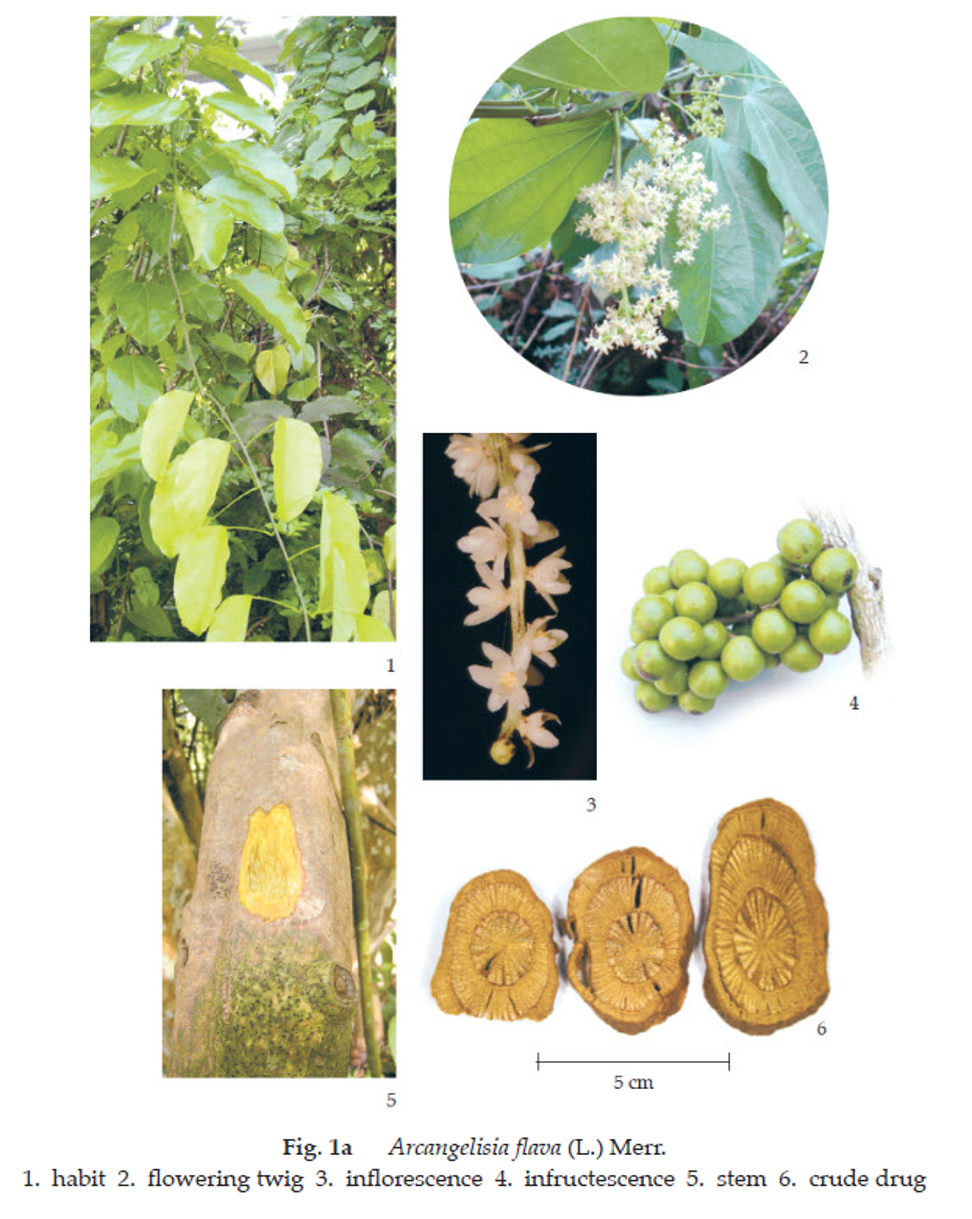
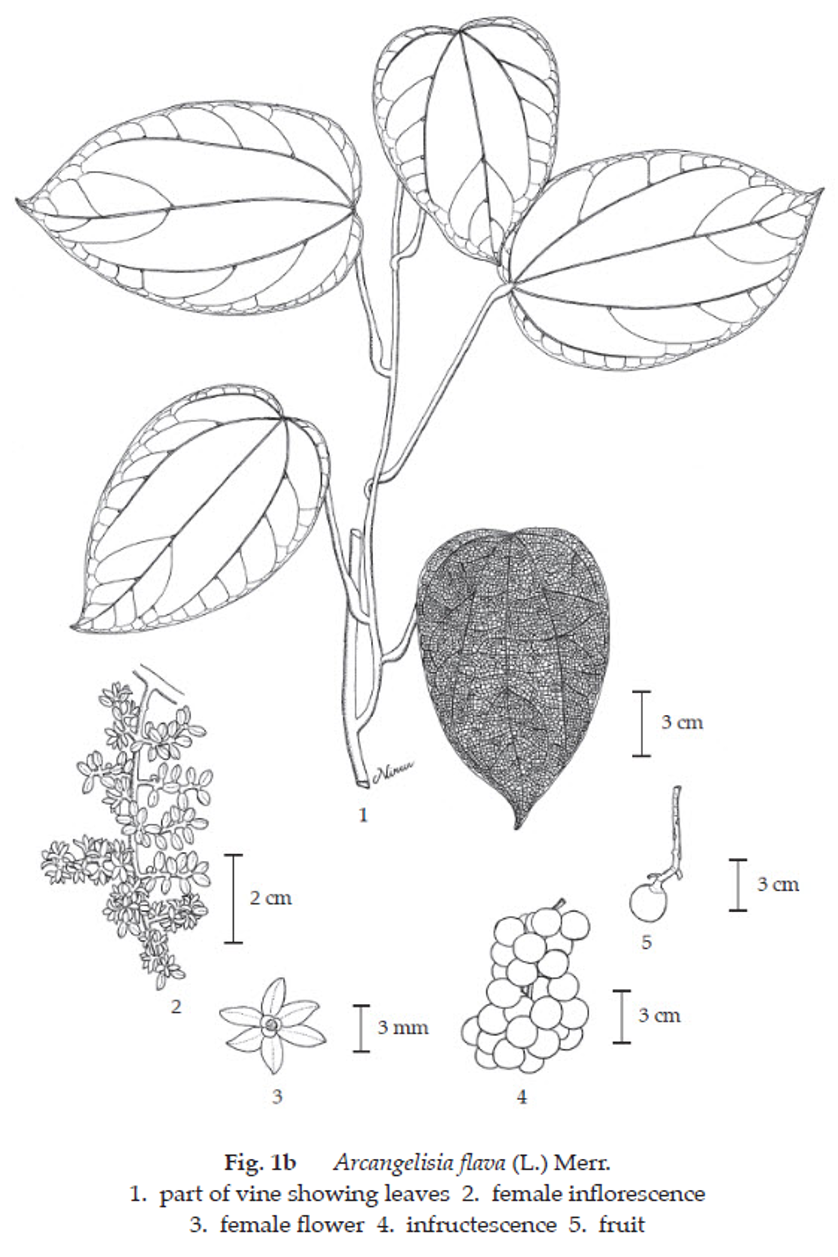
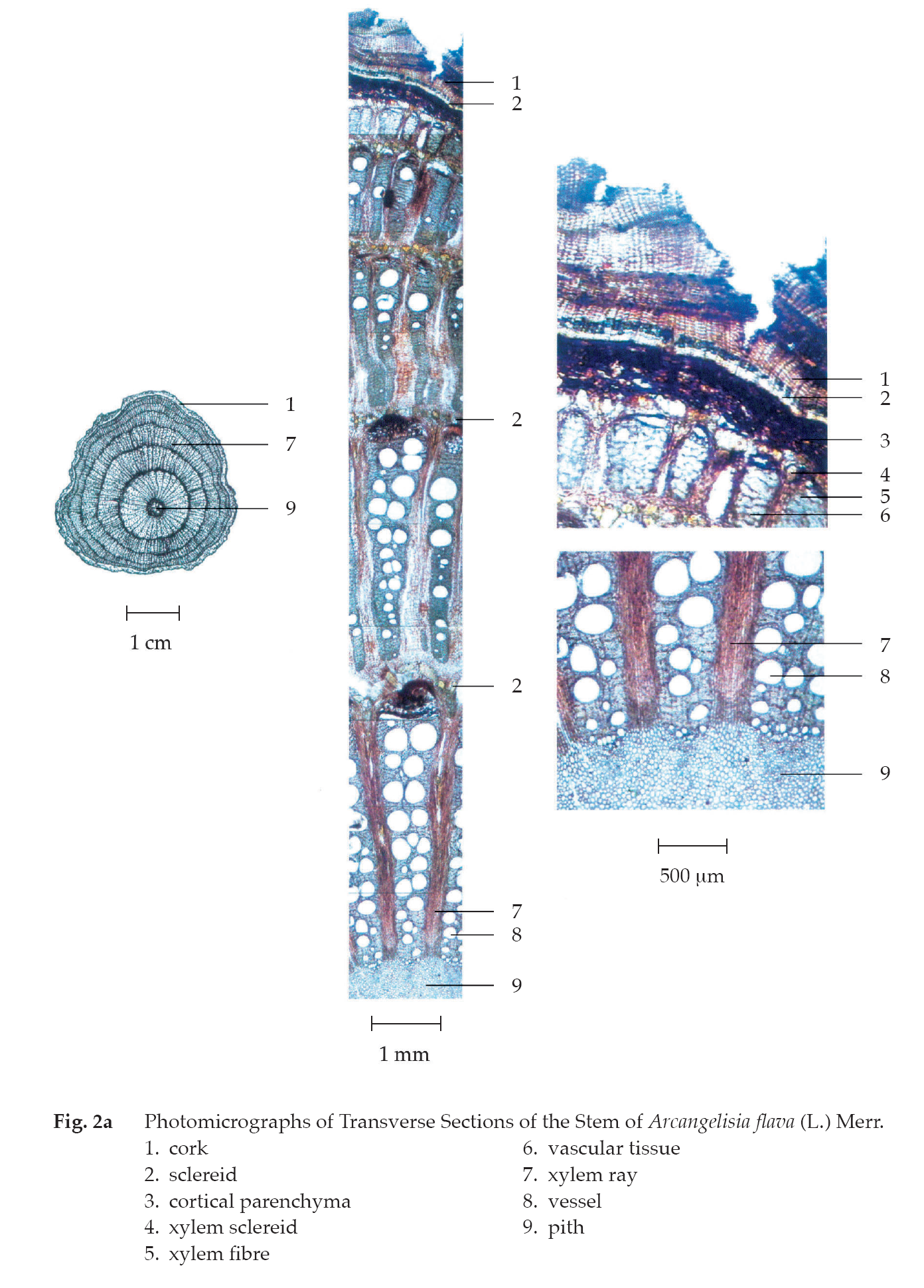
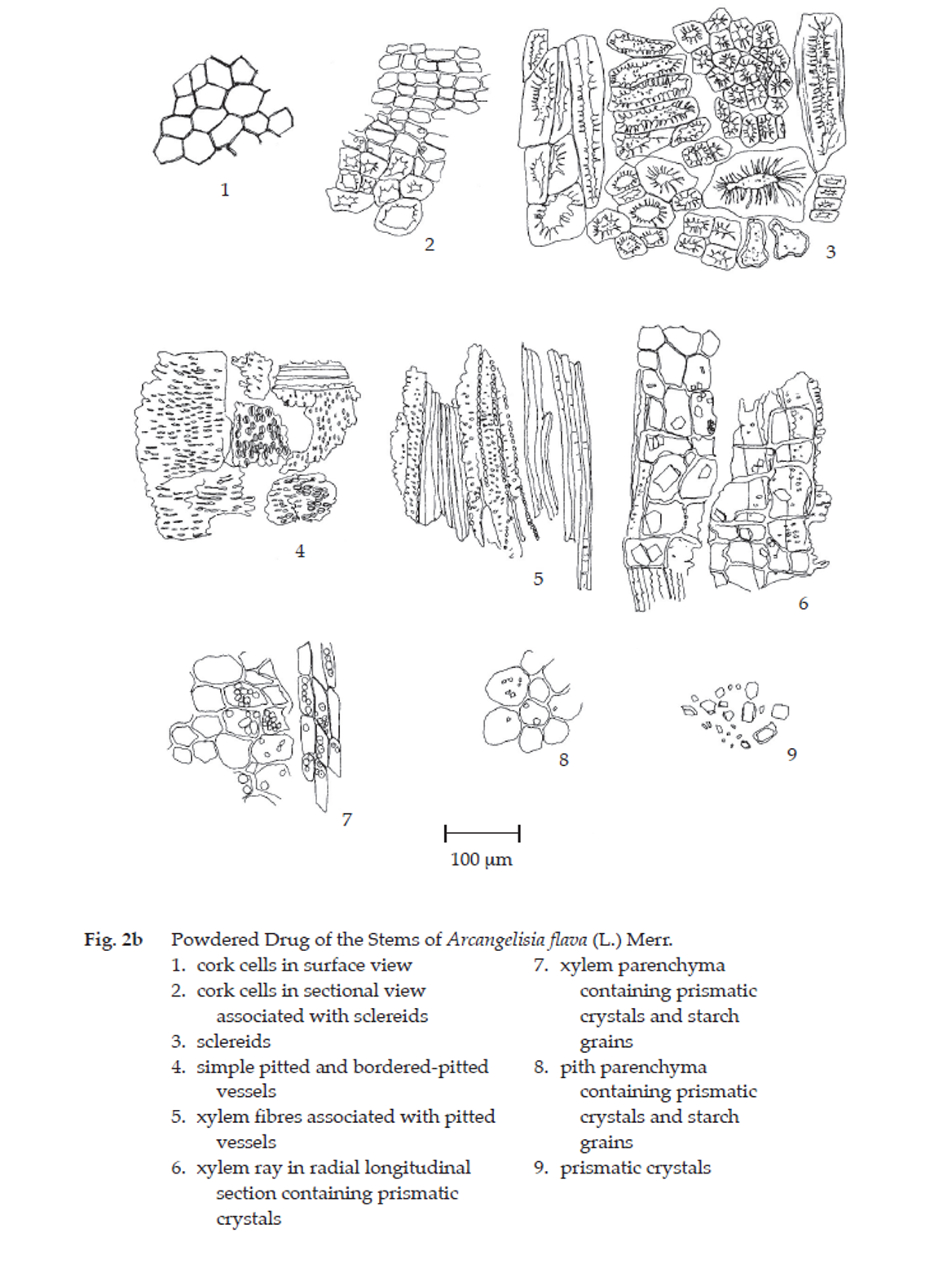
Arcangelisia Flava Stem in powder possesses the diagnostic microscopical characters of the unground drug.
Packaging and storage Arcangelisia Flava Stem shall be kept in well-closed containers, protected form light, and stored in a dry place.
Identification
A. Reflux 1 g of the sample, in fine powder, with 25 mL of methanol in a water-bath for 10 minutes, and filter (solution 1). Examine 2 mL of solution 1 under ultraviolet light (366 nm): a yellow fluorescence is observed.
B. To 2 mL of solution 1, add 0.5 mL of nitric acid and mix well: an orange colour develops.
C. Evaporate 2 mL of solution 1 to dryness, dissolve the residue in 2 mL of ether, add 0.5 mL of hydrogen peroxide TS (10 volumes), and mix. Carefully add 1 mL of hydrochloric acid to form a layer: a red ring forms at the zone of contact.
D. Evaporate 2 mL of solution 1 to dryness. Add a few drops of modified Dragendorff TS2 to the residue: an orange precipitate is produced.
E. Evaporate 5 mL of solution 1 to dryness. Dissolve the residue in 2 mL of 1.5 M sulfuric acid, add a few drops of 0.02 M potassium permanganate, and warm on a water-bath: the colour of potassium permanganate is decolorized.
F. Carry out the test as described in the “Thin-Layer Chromatography” (Appendix 3.1), using silica gel GF254 as the coating substance and a mixture of 70 volumes of 1-butanol, 20 volumes of water and 10 volumes of glacial acetic acid as the mobile phase and allowing the solvent front to ascend 12 cm above the line of application. Apply separately to the plate, 5 μL each of the following three solutions. Prepare solution (A) by refluxing 500 mg of the sample, in fine powder, with 20 mL of methanol for 5 minutes. Filter and evaporate the filtrate under reduced pressure to 5 mL. For solution (B), dissolve 1 mg of berberine chloride in 1 mL of water. For solution (C), dissolve 1 mg of palmatine iodide in 1 mL of water. After removal of the plate, allow it to dry in air and examine under daylight, locating the spots. The chromatogram obtained from solution (A) shows two yellow spots (hRf values 52 to 54 and 44 to 47) corresponding to the berberine chloride spot from solution (B) and the palmatine iodide spot from solution (C), respectively. Subsequently examine the plate under ultraviolet light (254 nm), marking the quenching spots. The chromatogram obtained from solution (A) shows two quenching spots corresponding to the berberine chloride spot from solution (B) and the palmatine iodide spot from solution (C) and other three quenching spots of lower hRf values. Examine the plate under ultraviolet light (366 nm); the spots due to berberine chloride and palmatine iodide show yellow fluorescences. Other several blue and one yellow spots are also observed. Spray the plate with a 10 per cent w/v solution of phosphomolybdic acid in ethanol and heat at 105° for 5 minutes; the spots corresponding to berberine chloride and palmatine iodide are brown. Other several blue spots are also observed (Table 1); see also Fig. 3.
Repeat the same procedure on another plate but spray with modified Dragendorff TS; the spots due to berberine chloride and palmatine iodide are orange (Table 1); see also Fig. 3.
Table 1 hRf Values of Components in Methanolic Extract of the Stems of Arcangelisia flava (L.) Merr.
| Spot |
hRf Value |
Detection | ||||
| Daylight | UV 254 | UV 366 | 10 Per Cent W/V Solution of Phosphomolybdic Acid in Ethanol |
Modified Dragendorff TS |
||
| 1 2 3 4 5 6 7 8* 9** 10 11 12 13 14 15 16 |
4-5 7-8 12-14 14-15 19 25-28 32-34 44-47 52-54 57 62-64 66-67 82 88 96-97 98 |
- - - - - - - yellow yellow - - - - - - - |
- quenching - quenching - - quenching quenching quenching - - - - - - - |
blue blue blue blue - blue blue yellow yellow blue yellow - - blue - - |
- - - blue blue - blue brown brown - - blue blue - dark blue dark blue |
- - - - - - - orange orange - - - - - - - |
*palmatine iodide
**berberine chloride
Loss on drying Not more than 10.0 per cent w/w after drying at 105° to constant weight (Appendix 4.15).
Acid-insoluble ash Not more than 0.5 per cent w/w (Appendix 7.6).
Total ash Not more than 3.0 per cent w/w (Appendix 7.7).
Ethanol-soluble extractive Not less than 4.0 per cent w/w (Appendix 7.12).
Water-soluble extractive Not less than 4.0 per cent w/w (Appendix 7.12).
Chloroform-soluble extractive Not less than 1.0 per cent w/w (Appendix 7.12H).
Berberine content Not less than 2.0 per cent w/w, calculated on the dried basis, when determined by the following method.
Standard berberine chloride stock solution Transfer about 40 mg of berberine chloride, previously dried at 110° for 4 hours and accurately weighed, to a 50-mL volumetric flask, dissolve in 30 mL of methanol, dilute to volume with a mixture of 1 volume of hydrochloric acid and 100 volumes of methanol, and mix.
Standard berberine chloride solution Dilute Standard berberine chloride stock solution quantitatively and stepwise with a mixture of 1 volume of hydrochloric acid and 100 volumes of methanol to obtain solutions having known concentrations of 80, 160, 240, 320, and 400 μg per mL, respectively.
Standard berberine chloride curve Place 2.5 mL of each standard solution in separate aluminium oxide minicolumns (about 15 × 1 cm), pretreated by filling the minicolumns with 2.5 g of neutral aluminium oxide using wet method and washing with about 15 mL of ethanol. Elute each column with 15 mL of ethanol in portions, combine the eluates in a 25-mL volumetric flask and dilute to volume with ethanol. Pipette 10 mL of each solution into separate 25-mL volumetric flasks and dilute to volume with 0.5 M sulfuric acid. Measure the absorbances of the solutions obtained at the maximum at about 345 nm, using 0.5 M sulfuric acid as the blank (Appendix 2.2). Plot the readings and draw the curve of best fit.
Procedure Place 500 mg of Arcangelisia Flava Stem, in fine powder and accurately weighed, in a soxhlet extractor of appropriate size. Add 25 mL of a mixture of 1 volume of hydrochloric acid and 100 volumes of methanol, extract to colourless and allow to cool. Quantitatively transfer the extract to a 50-mL volumetric flask and dilute to volume with a mixture of 1 volume of hydrochloric acid and 100 volumes of methanol. Transfer 2.5 mL of this solution to an aluminium oxide minicolumn, and proceed as directed under Standard berberine chloride curve, beginning with “pretreated by...”. Read the absorbance of the resulting solution, and by reference to the Standard berberine chloride curve, calculate the content of berberine in the Arcangelisia Flava Stem taken using 407.85 and 336.37 as the molecular weights of berberine chloride and berberine, respectively.
